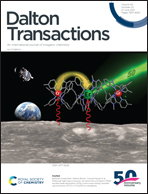Fixation of atmospheric CO2 as C1-feedstock by nickel(ii) complexes†
Abstract
The development of molecular catalysts for the activation and conversion of atmospheric carbon dioxide (CO2) into a value-added product is a great challenge. A series of nickel(II) complexes, [Ni(L)(CH3CN)3](BPh4)2, 1–4 of diazepane based ligands, 4-methyl-1-[(pyridin-2-yl-methyl)]-1,4-diazepane (L1), 4-methyl-1-[2-(pyridine-2-yl)ethyl]-1,4-diazepane (L2), 4-methyl-1-[(quinoline-2-yl)-methyl]-1,4-diazepane (L3) and 1-[(4-methoxy-3,5-dimethyl-pyridin-2-yl)methyl]-4-methyl-1,4-diazepane (L4), have been synthesized and characterized as catalysts for the activation of atmospheric CO2. The single-crystal X-ray structure of 1 shows a distorted octahedral geometry with a cis-β configuration around the NiN6 coordination sphere. All the complexes are used as catalysts for the conversion of atmospheric CO2 and epoxides into cyclic carbonates at 1 atmosphere (atm) pressure and in the presence of Et3N. Catalyst 4 was found to be the most efficient catalyst and showed a 31% formation of cyclic carbonates with a TON of 620 under 1 atm air as the CO2 source. This yield was enhanced to 94% with a TON of 1880 under 1 atm pure CO2 gas and it is the highest catalytic efficiency known for nickel(II)-based catalysts. Catalyst 4 enabled the transformation of a wide range of epoxides (eight examples) into corresponding cyclic carbonates with excellent selectivity (>99%) and yields of 59–94% and 11–31% under pure CO2 and atmospheric CO2, respectively. The catalytic efficiency is strongly influenced by the electronic nature of the complexes. The CO2 fixation reactions without an epoxide substrate led to the formation of the carbonate bridged dinuclear nickel(II) complexes [(LNiII)2CO3](BPh4)21a–4a, which are speculated as catalytically active intermediates. The formation of these species was accompanied by the formation of new absorption bands around 592–681 nm and was further confirmed by the ESI-MS and IR spectral studies. The molecular structures of these carbonate-bridged key intermediates were determined by X-ray analysis. The structures contain two Ni2+-centers bridged via a carbonate ion that originated from CO2. Distorted square pyramidal geometries are adopted around each Ni(II) center. All these results support that CO2 fixation reactions occur via CO2-bound nickel key intermediates.



 Please wait while we load your content...
Please wait while we load your content...